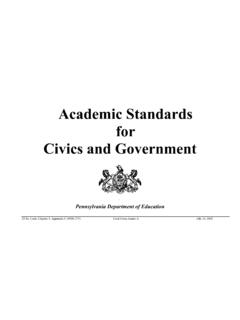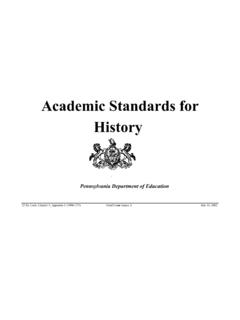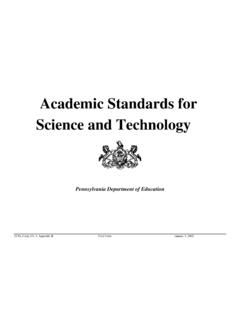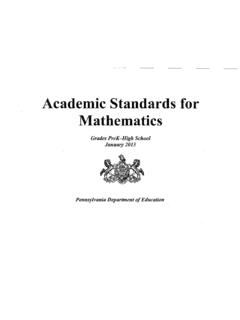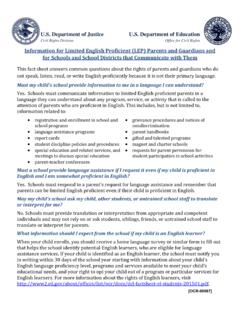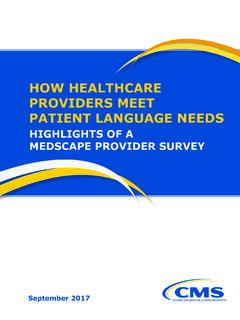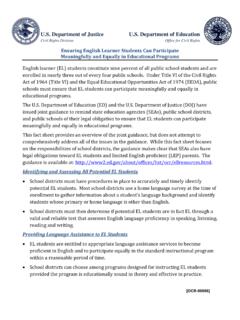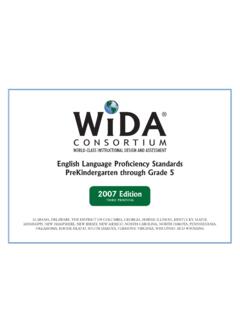Transcription of Standards for English Language Development
1 As approved by the State Board of Education on July 13, 2017 Standards for English Language Development July, 2017 Pennsylvania Department of Education As approved by the State Board of Education on July 13, 2017 TABLE OF CONTENTS 1 Grade Level Pre-K-Kindergarten: English Language Development Standards .. 2 Social and Instructional .. 2 Language Arts .. 3 Mathematics .. 4 Science .. 5 Social Studies .. 6 Grade Level 1: English Language Development Standards .. 7 Social and Instructional .. 7 Language Arts .. 8 Mathematics .. 10 Science .. 11 Social Studies .. 12 Grade Level 2-3: English Language Development Standards .. 13 Social and Instructional.
2 13 Language Arts .. 14 Mathematics .. 16 Science .. 17 Social Studies .. 18 Grade Level 4-5: English Language Development Standards .. 20 Social and Instructional .. 20 Language Arts .. 22 Mathematics .. 23 Science .. 24 Social Studies .. 25 Grade Level 6-8: English Language Development Standards .. 26 Social and Instructional .. 26 Language Arts .. 27 Mathematics .. 28 Science .. 30 Social Studies .. 31 Grade Level 9-12: English Language Development Standards .. 32 Social and Instructional .. 32 Language Arts .. 33 Mathematics .. 34 Science .. 35 Social Studies .. 36 APPENDIX A: A Deeper Understanding .. 37 Page 1 of 43 Introduction English Language Development Standards Framework The Pennsylvania Department of Education convened the English Language proficiency Standards Workgroup in 2015 to revise, update and correlate the existing English Language proficiency Standards to the newly developed, more rigorous Pennsylvania Core/Academic Standards , thus giving ELs equitable access to subject content.
3 As part of this work, the Department recognized the need to incorporate changes in research-based instruction that impacts Language Development and improves academic achievement. Standards The framework was modeled after WIDA s English Language proficiency Standards for English Language Learners in Kindergarten through Grade 12: Frameworks for Large-scale State and Classroom Assessment developed by the WIDA consortium of states. The framework retains the five overarching Standards previously adopted by Pennsylvania. Pennsylvania English Language Development Standards The PA ELDS Framework is designed to help educators effectively differentiate instruction and assessment across content areas for ELs at varying levels of English Language proficiency (ELP).
4 The framework incorporates the acquisition of social and academic Language across Development levels and the incremental demands of Language through various grade levels. Standard 1. English Language learners communicate in English for SOCIAL AND INSTRUCTIONAL purposes within the school setting. Standard 2. English Language learners communicate information, ideas, and concepts necessary for academic success in the content area of Language ARTS. Standard 3. English Language learners communicate information, ideas, and concepts necessary for academic success in the content area of MATHEMATICS. Standard 4. English Language learners communicate information, ideas, and concepts necessary for academic success in the content area of SCIENCE.
5 Standard 5. English Language learners communicate information, ideas, and concepts necessary for academic success in the content area of SOCIAL STUDIES. As approved by the State Board of Education on July 13, 2017 English Language Development Standard 1: English Language learners communicate information, ideas, and concepts necessary for academic success for Social and Instructional purposes. Grade Level: Pre-K-Kindergarten Level 1 Entering Level 2 Emerging Level 3 Developing Level 4 Expanding Level 5 Bridging Standards RECEPTIVE Listening Follow one-step oral commands with teacher modeling. Follow one-step oral commands in a small group. Follow two-step oral commands in a small group.
6 Follow oral directions as presented in a context ( conversation, song) in a small group. Follow sequential commands with visual or non-verbal cues. Reading Sort labeled pictures of familiar objects ( classroom items, family members) with teacher modeling. Identify the first letter of own name and/or names of familiar adults and children from a list. Name letters from own name and match to letters found in classroom print with a partner. Match pictures of classroom objects beginning with similar sounds too familiar words ( , pen, pencil) in a small group. Identify or read words in functional print with visual cues with a partner. PRODUCTIVE Speaking Repeat and respond to chants about asking an adult for help in small groups using gestures.
7 Produce simple statements about asking an adult for help using oral sentence starters and models. Produce expanded statements about asking an adult for help using oral sentence starters and models. Tell about a time you asked for an adult for help using models. Elaborate with details on a time you asked an adult for help using models. Writing Draw and/or label family members using models and illustrated word cards ( , grandma) in L1 or L2. Draw and label family members using models and illustrated word cards ( , This is _____.) in L1 or L2. Draw and describe family members using sentence frames and illustrated word cards ( , This is ____. He is _____.)
8 Produce illustrated stories about family members using related sentence frames and illustrated word cards. Produce illustrated stories about family members with a classroom aide. As approved by the State Board of Education on July 13, 2017 Page 3 of 43 English Language Development Standard 2: English Language learners communicate information, ideas, and concepts necessary for academic success in the content area of Language Arts. Grade Level: Pre-K-Kindergarten Level 1 Entering Level 2 Emerging Level 3 Developing Level 4 Expanding Level 5 Bridging Standards RECEPTIVE Listening Mimic teacher physical movements while listening to songs or chants ( , Itsy Bitsy Spider or Head, Shoulders ).
9 Perform physical actions independently in response to verbal prompts in rehearsed songs or chants in a small group. Perform physical actions independently in response to verbal prompts in rehearsed songs or chants. Reenact part of a song or chant in response to verbal prompts in a small group. Reenact songs or chants in response to verbal prompts and digital media. Reading Sequence labeled pictures of main story events ( , first, next, last) with teacher support. Sequence labeled pictures of main story events and key details with teacher support and/or a partner. Sequence main story events and key details using labeled pictures. Match illustrations of key story details with sequence words cards in a small group.
10 Locate sequence words in a story with visual support ( , illustrated flash cards or word wall). PRODUCTIVE Speaking Respond to Yes/No questions about an illustrated story. Respond to questions with one or two words or short phrases about an illustrated story. Retell a story with visual supports ( , realia, pictures, puppets) with a partner. Summarize the events of a story using visual supports with a partner. Express an opinion about a story or experience using visual supports and speaking prompts ( , I ; I ) Writing Illustrate a shared experience or event with teacher modeling. Illustrate and label a shared experience or event using invented spelling with a partner.




